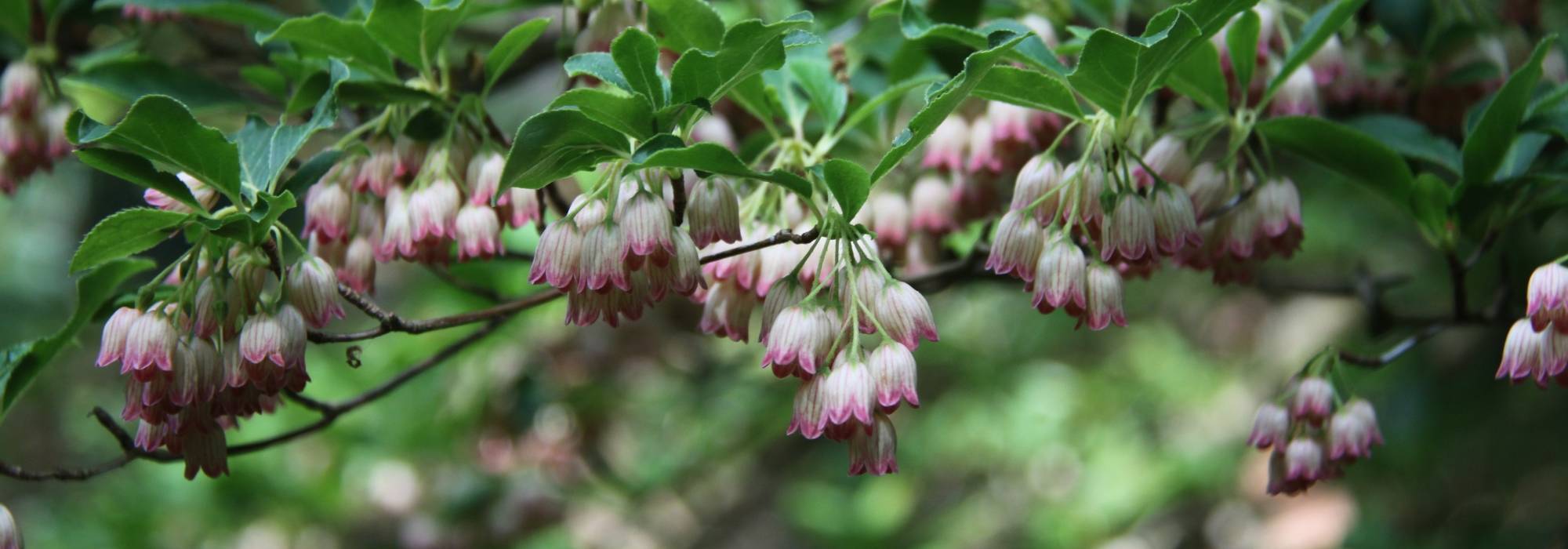
Enkianthus, campanulate andromeda: how to plant, grow and care?
Contents
Enkianthus in a nutshell
- Still too little known, you will appreciate Enkianthus perulatus and Enkianthus campanulatus for their spring flowering in pendulous clusters and their superb autumn foliage
- From April to June, these deciduous bushes are covered in a multitude of small, fragrant white or pink bell-shaped flowers of extraordinary delicacy
- They thrive in partial shade in heather soil
- With very slow growth, they nevertheless tolerate severe cold very well
- They can be used in mass planting, as specimens or even in pots
A word from our expert
Still all too rarely seen in our gardens, Enkianthus is a heather soil bush that offers sumptuous autumn-coloured foliage and a spring flowering of infinite delicacy.
In our gardens, Enkianthus campanulatus or “andromède campanulate” and Enkianthus campanulatus var. palibinii will slowly reach 3 to 5 m, however some dwarf cultivars such as Enkianthus campanulatus ‘Hollandia’ do not exceed 1.20 m in height and are perfectly suited to small gardens. Enkianthus perulatus (syn. Enkianthus japonicus) has a more compact form and an elegant, neat silhouette. Enkianthus quinqueflorus is a little-known species rarely grown in our gardens.
From April to May, Enkianthus is covered with a multitude of scented little bells opening into campanulate corollas of flesh-pink, raspberry-red (Enkianthus campanulatus ‘Red Bells’), cream veined with red (Enkianthus campanulatus ‘Venus’), or white edged with pink (Enkianthus campanulatus ‘Pagode’).
Original, these bright bunches of flowers light up shady corners in spring, while in autumn the bush takes on superb flaming foliage, its leaves turning gold and scarlet red.
This acidophilous bush needs fresh heather soil in which it grows very slowly in the shade of trees and sheltered from cold winds.
Pruning of Enkianthus campanulatus is not obligatory, but you can do it to control its growth.
With its slow development and elegant yet compact habit, Enkianthus adapts to all uses; in mixed borders with ericaceous plants such as Rhododendrons and pieris, as a specimen and even in a container on a shaded terrace.
Hardy and easy to grow, Enkianthus is among the most beautiful heather soil bushes. Be seduced by its singular flowering and autumn display!
Description and botany
Botanical data
- Latin name Enkianthus
- Family Ericaceae
- Common name Redvein Enkianthus, campanulate andromeda
- Flowering April to June
- Height 0.6 to 5 m
- Exposure sun, partial shade
- Soil type acidic, heather soil
- Hardiness -15 to -20°C
Native to woods and thickets of Japan and southern China, notably Taiwan, Enkianthus is a deciduous bush belonging to family Ericaceae, like heathers, rhododendrons and andromedas to which it is closely related. Genus Enkianthus comprises about ten species of shrubs or small trees, among which Enkianthus campanulatus, also called “campanulate andromeda”, is the most widely cultivated and is available in different forms such as Enkianthus campanulatus var. palibinii and various cultivars like ‘Red Bells’. Enkianthus perulatus (probable synonym of E. japonicus) or “white enkianthus”, a small species with a more compact habit, is also frequently grown.
Enkianthus quinqueflorus, a species with large leaves and flowers, Enkianthus chinensis and Enkianthus cernus are rarely seen in our gardens.
Slow-growing, this bush develops slowly to form, depending on species, a small tree with an upright habit, often narrow, sometimes spreading or globose, bushy and well ramified from the base. In Enkianthus campanulatus, shoots grow in whorls, giving the bush a well-balanced, harmoniously tiered branch structure. The largest Enkianthus will reach, after many years, about 2 up to 4–5 m in all directions. Dwarf varieties exist not exceeding 60 cm to 1.20 m in height, modest dimensions that allow cultivation in a pot and training as bonsai or cloud-pruned specimens.
Many years are required to see it form a true small tree: patience rewarded by good longevity in the garden and a delicate, original spring flowering.
From April to June, sometimes before leafing, Enkianthus is covered with a multitude of campanulate or urn-shaped bells, borne in umbels or in fine pendulous clusters at the tips of shoots. The flowers, 0.5 to 2 cm wide and formed of five fused petals, sway gracefully at the end of long pubescent pedicels, sometimes slightly raspberry-tinged.
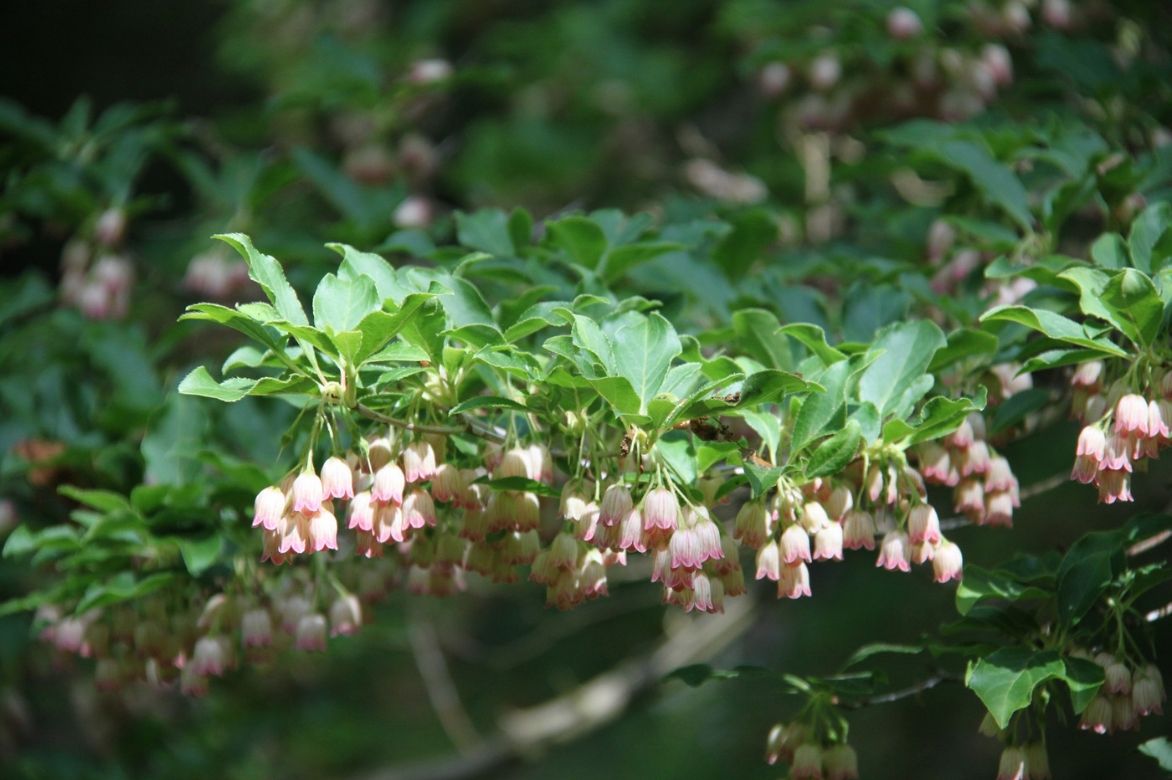
Delicate bell-shaped flowers of the campanulate andromeda
Gathered in corymbs of 5 to 20 beneath the leaf fans, they offer a slightly waxy texture. Exquisitely delicate, these swollen corollas set in an acid-green or greenish-pink calyx, range through all shades of cream-white and pink, and even a red so brilliant at times it evokes currant clusters. United, they are also subtly veined with carmine or white striations depending on variety, offering tonal variations of soft colours.
Slightly scented, these exquisite melliferous and nectariferous bell flowers resemble those of Pieris japonica and last about a month.
After flowering, brown fruits in the form of ovoid, winged capsules appear and persist through winter.
Dense, deciduous foliage consists of leaves arranged in clusters alternately at the tips of sometimes reddish shoots, 2 to 7 cm long by about 2 cm wide, lanceolate, elliptical to ovate, very finely dentate and veined. Leaves are matte, glossy or sometimes downy on upper surface or underside and form denser groups at branch tips.

Enkianthus campanulatus : fruiting and autumn foliage
This attractive foliage, bright green or blue-green in spring, puts on a magnificent autumn display. It then adopts beautiful autumnal tones ranging from gold to yellow-orange and to scarlet red before falling.
Enkianthus is perfectly hardy and tolerates temperatures down to -15°C, even lower, provided it is planted in a sheltered position. It can therefore be grown in many parts of France. Native to damp woods, it prefers semi-shaded positions in the garden and requires acidic, lime-free soil as it is a heather soil plant.
It is used as well in mixed borders with other ericaceous shrubs, in woodland understorey, and also in a large container on a terrace.
Read also
Plant young ericaceous plantsMain species and varieties
Campanulate Enkianthus is the tallest species and the most widespread in our gardens. It has given rise to remarkable cultivars with subtly bicoloured flowers and to a hybrid form, Enkianthus campanulatus var. palibinii.
Our favourites
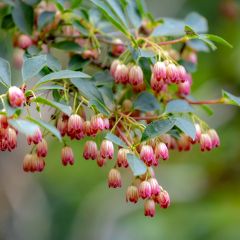
Enkianthus campanulatus
- Flowering time June, July
- Height at maturity 1,50 m
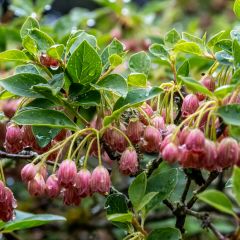
Enkianthus campanulatus Red Bells
- Flowering time June, July
- Height at maturity 2,50 m
Discover other Enkianthus
View all →Available in 2 sizes
Available in 1 sizes
Available in 1 sizes
Available in 1 sizes
Available in 1 sizes
Planting
Where to plant Enkianthus?
Very hardy, Enkianthus does not fear cold and withstands as low as -15°C to -20°C, sometimes even lower, without failing. However, planting sheltered from cold, drying winds is recommended; young shoots can be sensitive to late frosts.
This bush prefers semi-shaded positions, sheltered from direct sun, under the dappled shade of large trees. Avoid placing it in too deep shade, as it needs light to flower well and to produce attractive autumn colours. It will establish less easily south of the Loire, as it dislikes burning sun and drought. It can tolerate a few hours of sun in the morning or late afternoon only if soil remains cool.
Easy to grow, it only needs cool, acidic conditions to thrive.
It is an acidophilous bush that above all dislikes lime and requires acidic soil, ideally heather soil: plant it in a cool, well-drained, light, humus-bearing, non-calcareous soil.
Slow-growing, it is a compact bush, ideal planted singly in small formal gardens and town gardens. Very versatile, Enkianthus is used equally in shrub borders with other heather soil bushes, with spring-flowering perennials, in clumps at woodland edges surrounded by spring bulbs or in a pot on a shaded terrace.
Plant the tallest varieties in a sheltered wooded spot to thicken a hedge; dwarf varieties (Enkianthus perulatus ‘Compacta’, Enkianthus campanulatus ‘Hollandia’) in a cool rock garden or in a pot, trained like a bonsai.
When to plant Enkianthus?
Plant Enkianthus ideally in autumn, from September to November, or in spring, from March to May, outside periods of frost.
How to plant Enkianthus?
In open ground
Like all heather soil bushes, Enkianthus dislikes calcareous soil in which it would not survive. In any case, it is preferable to add some heather soil at planting (pH should be below 6.5).
If your soil is too calcareous, replace excavated soil with a mixture of heather soil and leaf mould, preferably plant in a pot or simply accept not to fight its acidophilous nature. Turn to a bush less intolerant of lime unless you are prepared to add heather soil regularly in varying amounts. Avoid areas where water pools in winter: plant on a mound if necessary.
- Dig a planting hole about two to five times wider than the root ball
- Add gravel, pumice or a good layer of clay pebbles to the bottom of the hole to ensure good drainage
- Place your Enkianthus at collar level in a mixture of loam, turf, heather soil and leaf mould
- Backfill and firm down
- Water well
- Spread a good layer of bark mulch or pine needles around base of the bush
- Water regularly during the first year with rainwater
How to plant a bush in heather soil, it’s easy if you follow our advice!
Growing in a pot
You can also grow Enkianthus in a pot; its slow growth allows this type of culture. We recommend opting for dwarf varieties. Choose a container large and deep enough (30 to 40 cm diameter), then plant your bush in a free-draining mix of garden soil, turf and 50% genuine heather soil. Increased attention to watering will be essential. Mulch the base or plant small perennials such as small cyclamens, brunnera, dodecatheon or hardy geraniums to help retain freshness.
Read also
Pruning spring-flowering bushesMaintenance, pruning and care
Once well established in non-calcareous soil suited to its nature, Enkianthus will need little attention apart from regular watering, especially during the two summers following planting. It must never lack water; it needs a moist, cool soil in summer but dislikes excess water in winter. Water with non-calcareous water; prefer rainwater. Enkianthus grown in containers need more frequent watering.
In spring, spread a layer of organic mulch (bark or pine needles, tapetum of dead leaves, fern fronds), renewed each year, to keep its roots cool during summer heat and reduce watering.
If desired each spring, topdress the base with well-rotted compost and heather soil.
Remove faded flowers after flowering to prevent seed formation that exhausts the plant.
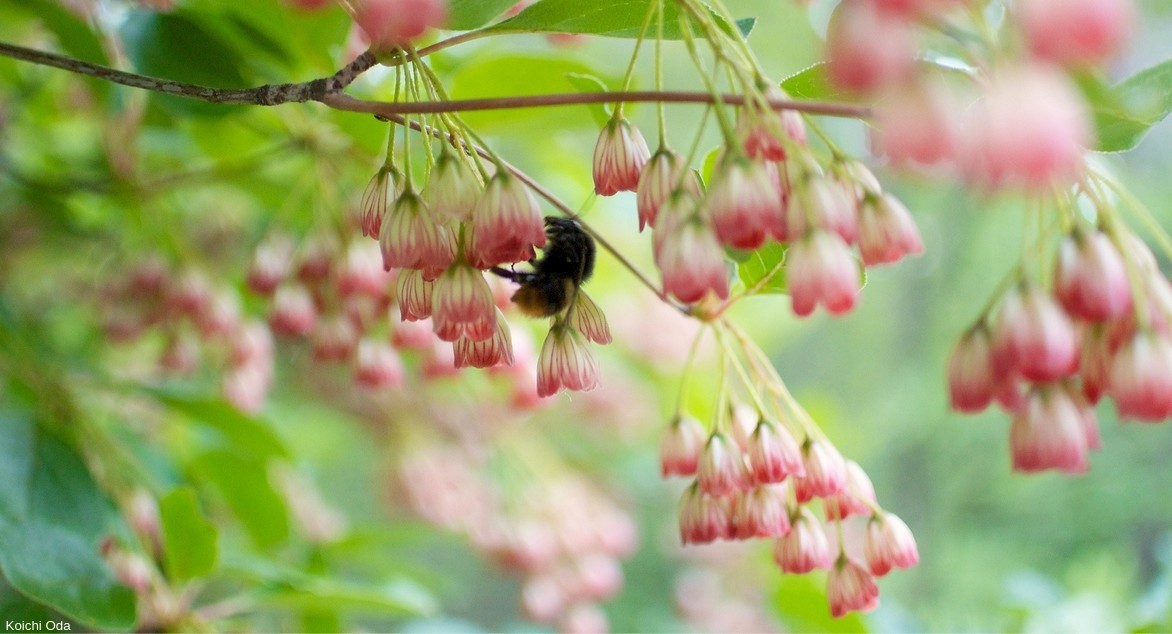
Growing slowly, pruning is unnecessary but it will, on the larger varieties, help rebalance their shape and limit height. Pruning is carried out after flowering. Only intervene to remove any dead or poorly placed branches.
The smallest varieties such as cultivars of Enkianthus perulatus can be shaped as desired and trained as a small tree, as bonsai, or even pruned into cloud shapes. Discover more advice in our sheet for “How to prune spring-flowering bushes“.
Grown in good conditions, Enkianthus has no known pests. If your soil is calcareous, however, it may develop chlorosis, characterised by yellowing of foliage: before any planting, consider adding heather soil and water only with rainwater.
Propagation
Multiplication of Enkianthus can be done by sowing in spring, however this technique is fairly delicate. Layering is also possible at the end of summer to multiply Enkianthus, but patience is required, as root development is very slow. That is why we recommend propagation by cuttings in summer (August–September), once flowering has finished, on semi-woody shoots.
By semi-ripe cuttings
- Take 10–20 cm shoots with heel
- Cut cleanly just below a leaf
- Remove leaves from lower part of cuttings
- Keep leaves on upper part
- Plant them in a light, well-draining mix of potting compost and sand
- Firm down
- Keep cuttings regularly moist with a sprayer
- Pot them into buckets as soon as they have formed roots
- Overwinter frost-free at 20 °C in a bright place but sheltered from direct sun
- Plant out in ground or in pot the following spring
Pour en savoir plus, lisez notre tutoriel : How to propagate Japanese Andromeda?
Associating
Enkianthus offers two beautiful seasons: spring when it is covered with delicate bell-shaped flowers in pastel shades and autumn when its foliage turns gold, orange or deep red, allowing wonderful combinations in semi-shaded areas of the garden.
Its flowering is inspiring in a romantic garden, in pink or in white schemes to which it lends freshness and delicacy. Pruned into cloud-like shapes in bonsai fashion, this bush will complete a zen, Japanese-inspired garden with Japanese azaleas, architectural grasses and Phormium.
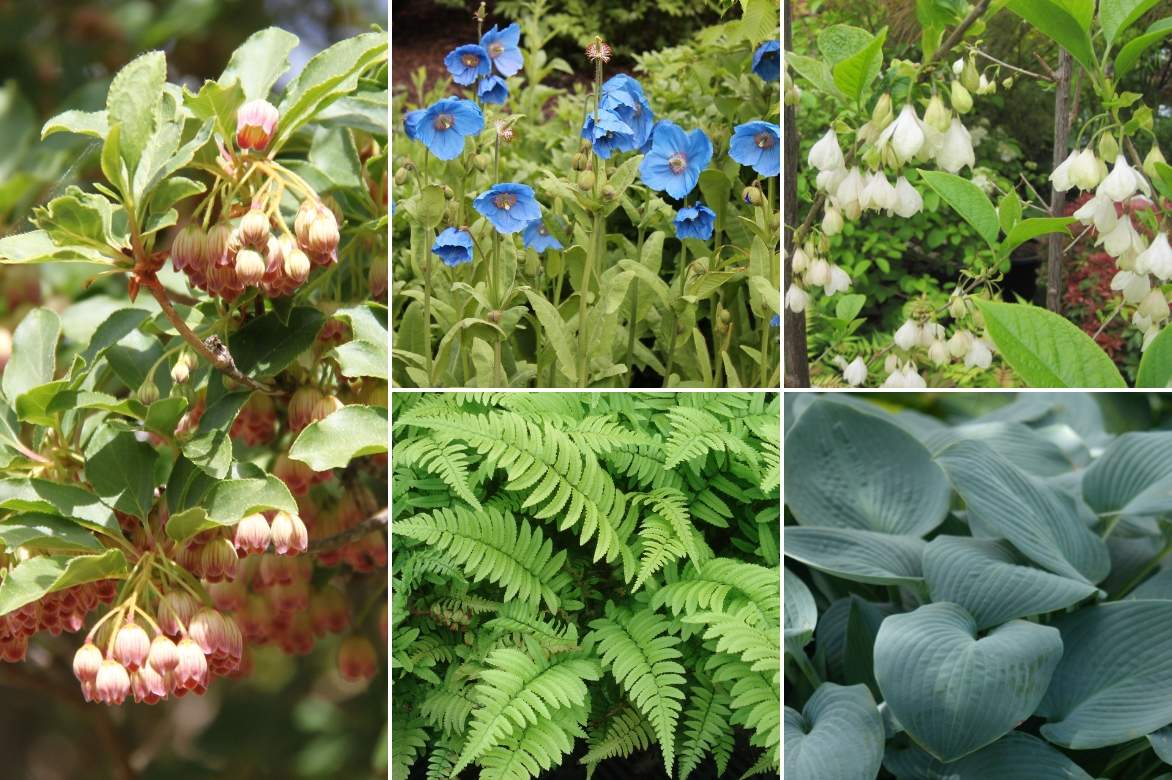
An idea for planting in acidic soil and a shaded area: Enkianthus campanulatus, Meconopsis betonicifolia, Dryopteris cycadina (syn. atrata) and Hosta ‘Halcyon’ under the canopy of a Halesia carolina
It naturally finds its place in a large border surrounded by other heather-soil bushes, and will be magnificent alongside Pieris, Rhododendrons, Camellia, Kalmia, azaleas and other closely related plants such as Leucothoe, hydrangeas or Skimmia.
It pairs easily with shade-loving perennials such as ferns, brunnera, heucheras, Epidemium, pachysandra or hostas.
In spring, create fresh, romantic scenes and surround its base with spring-flowering bulbs such as cyclamen coum, lilies, pink tulips and white daffodils.
Useful resources
- What to plant in a wooded garden? Here are our ideas to make the most of garden shade
- They set autumn alight with their blazing foliage: discover our unique collection of bushes with coloured autumn foliage
Frequently asked questions
-
In ground for two years, my Enkianthus isn't shooting!
That's normal — this bush is very slow to establish: its root system develops very slowly in soil. It will take many years to see it form a proper little tree. Its slow growth is matched only by a respectable longevity!
-
My Enkianthus leaves are yellowing. Why?
Intolerant of lime, its leaves discolour and turn yellow when excess lime causes chlorosis. It must be planted in non-calcareous heather soil. The cause may simply be the water used for watering. Water only with rainwater.
- Subscribe!
- Contents
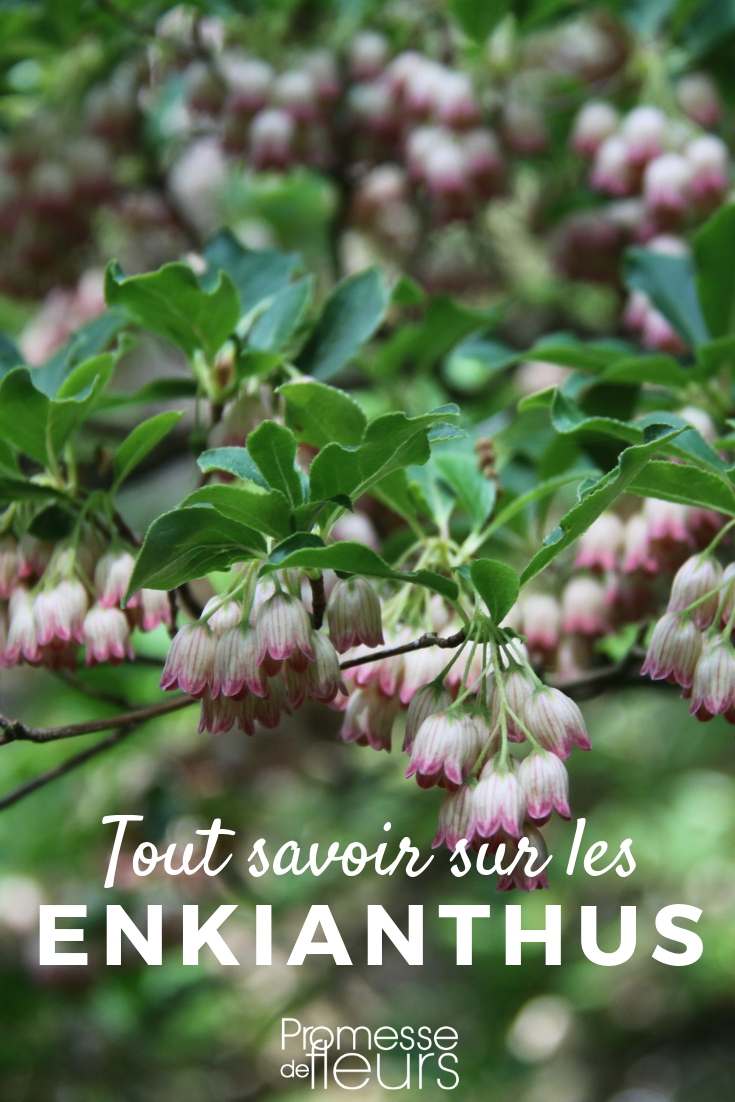

































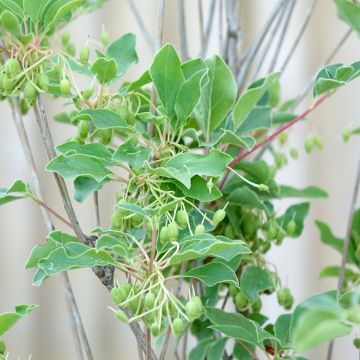
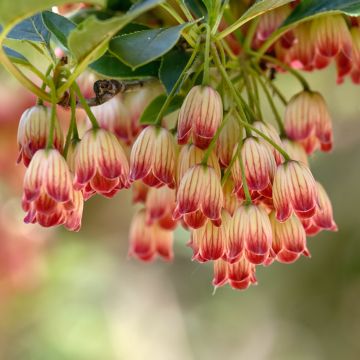
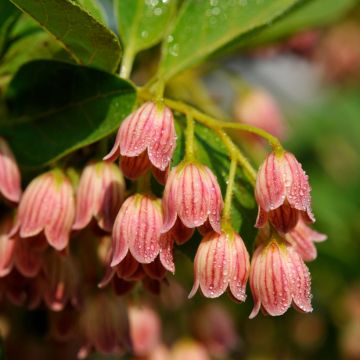
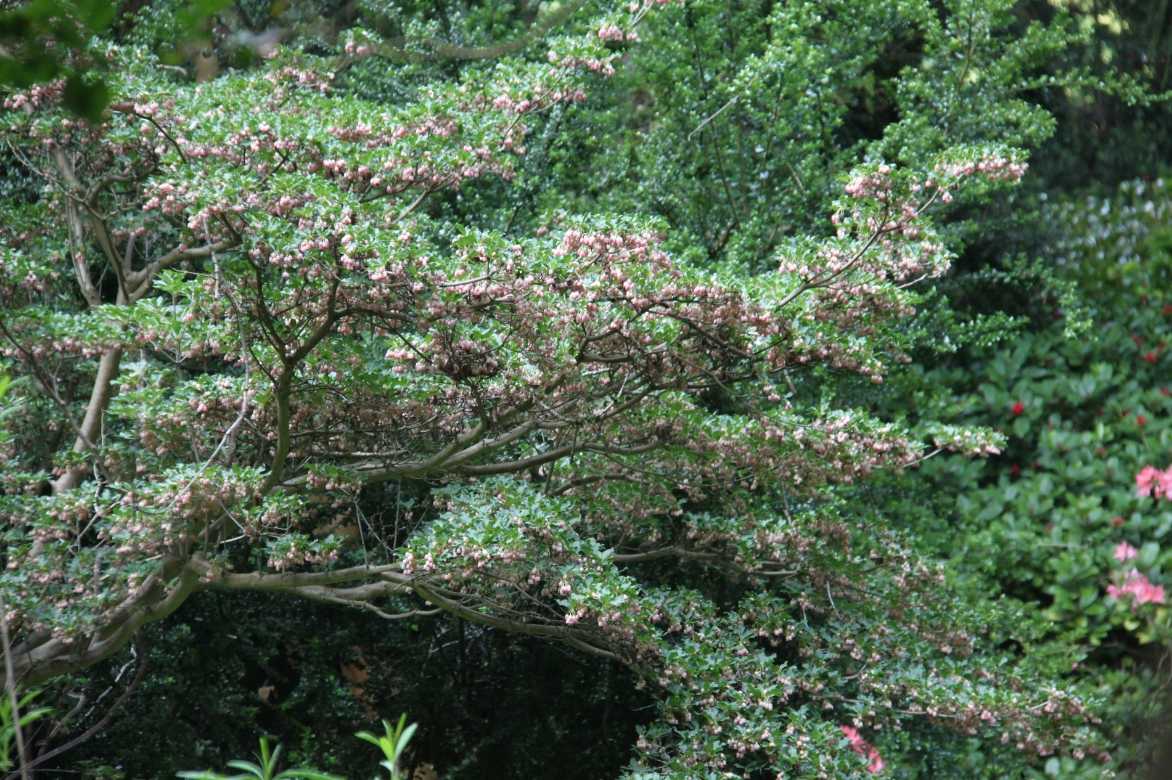
Comments